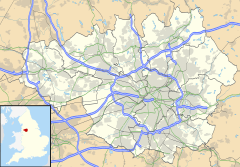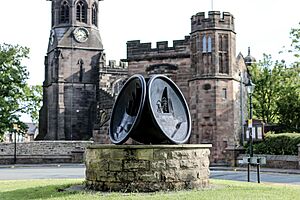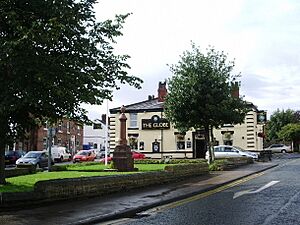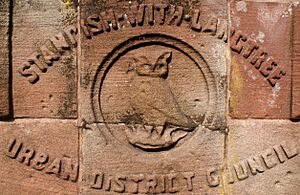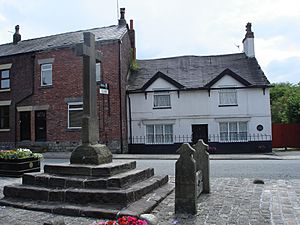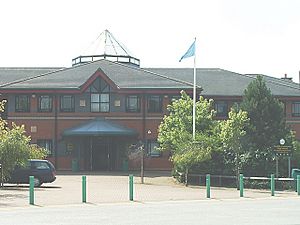Standish, Greater Manchester facts for kids
Quick facts for kids Standish |
|
|---|---|
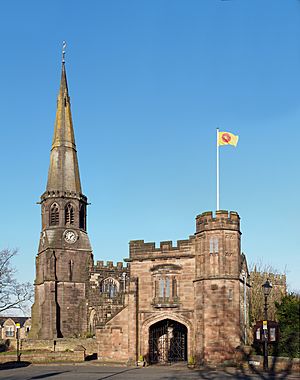 St Wilfrid's Church |
|
| Area | 5.1 sq mi (13 km2) |
| Population | 13,278 |
| • Density | 2,604/sq mi (1,005/km2) |
| OS grid reference | SD560102 |
| • London | 179 mi (288 km) |
| Metropolitan borough |
|
| Metropolitan county | |
| Region | |
| Country | England |
| Sovereign state | United Kingdom |
| Post town | WIGAN |
| Postcode district | WN1 WN6 |
| Dialling code | 01257 |
| Police | Greater Manchester |
| Fire | Greater Manchester |
| Ambulance | North West |
| EU Parliament | North West England |
| UK Parliament |
|
Standish is a town in Greater Manchester, England. It is part of the Metropolitan Borough of Wigan. Historically, Standish was in Lancashire. The town is located on the A49 road between Chorley and Wigan. It is also close to Junction 27 of the M6 motorway. In 2011, about 13,278 people lived in Standish.
Standish grew up around a main crossroads. As cities like Manchester and Liverpool expanded, Standish also grew. A very important building in the town is St Wilfrid's Church. It is a Grade I listed building, which means it is a very old and special church.
Contents
Discovering Standish's Past
The name Standish comes from old English words. Stan means stone, and edisc means a park or enclosed area. Over time, the name was written in different ways, like Stanedis in 1206 and Standisch in 1330. The nearby village of Langtree also has an old name, Langetre.
Long ago, a Roman road passed through this area. This shows that people have lived here for a very long time.
Early Land Owners
In the 12th century, Standish and Langtree were part of a large area called the Penwortham barony. Between 1150 and 1164, a lord named Richard Bussel gave these lands to his brother-in-law. Later, other powerful families, like the Earl of Derby, owned the land. The people who lived on the land started using the names Standish and Langtree as their own family names.
The Standish Family and Their Hall
From the 1200s, the Standish family became the main lords of Standish. They owned Standish Hall and its lands. The oldest part of Standish Hall was built in 1574. The last male in the Standish family line died in 1755. After that, the estate was passed down through female relatives. The hall was eventually taken down in parts during the 1900s. However, some of its beautiful wooden rooms were saved and moved to the United States.
Mining History in Standish
The Standish family were also important in coal mining. People had been mining coal on their land since the 1300s. Coal mining grew a lot during the Industrial Revolution. This was a time when new machines changed how things were made.
In the mid-1860s, the Standish coal mines joined a bigger company called the Wigan Coal and Iron Company. By 1896, this company owned many mines in the area, including Langtree Pit. Langtree Pit was the largest, with over 540 workers.
A new mine called Victoria Colliery opened in 1900. It kept working until 1958. Today, houses stand where this mine used to be.
Exploring Standish's Location
Standish is about 3.25 miles (5.2 km) north-northwest of Wigan. It is also about 19 miles (30.6 km) northwest of Manchester and 18 miles (29 km) northeast of Liverpool. The main A49 road goes right through the town center, connecting Wigan to Chorley.
The M6 motorway has an exit (Junction 27) to the west of Standish. The West Coast Main Line, a major railway, is about a mile east of the town center. The River Douglas and Bradley Brook form the eastern border of Standish. Mill Brook forms the western border. Standish is on high ground, reaching up to 370 feet (113 meters) in some places.
Local Areas and Surroundings
The area of Standish is in the south, and Langtree is to the north. Together, they cover about 3,264 acres (5.1 square miles). The village of Shevington is about 1.5 miles (2.4 km) to the west. Shevington Moor is to the northwest, near Langtree. Standish Lower Ground is a separate community about 1.75 miles (2.8 km) to the southwest.
The ground in Standish is mostly clay. Underneath are the coal measures of the Lancashire Coalfield, which means there's a lot of coal underground.
Who Lives in Standish?
Standish has a population of 13,278 people. This number comes from the 2011 census. It makes up about 4.2% of all the people living in the Wigan Borough.
Standish has more people over 65 years old than the average. About 19.9% of the population is in this age group. It is also a well-off community. Most people (80%) own their homes or are paying a mortgage. Only about 10% of households live in social housing.
How Standish is Governed
Since the early 12th century, Standish has been part of Lancashire. In the Middle Ages, it was a township. Later, in the mid-1800s, it joined with Langtree to become Standish-with-Langtree. This area was part of the larger Standish ecclesiastical parish, which is a church district.
In 1872, Standish-with-Langtree created a local board of health. This group was in charge of keeping the area clean and healthy. Later, in 1894, this board became an urban district within Lancashire.
In 1974, the Standish-with-Langtree Urban District was removed. Since then, Standish has been part of the Metropolitan Borough of Wigan. This is a local government area within Greater Manchester. For voting, the town is in the Standish With Langtree Ward.
Standish Voice Group
A local group called Standish Voice started in 2014. In 2015, it became the official Neighbourhood Forum for Standish. Their goal was to create a Neighbourhood Plan for the town. This plan helps guide how land is used and developed in Standish. In 2019, people voted on the plan, and 94.5% voted yes! This plan is now a legal document that helps shape the future of Standish.
Important Places in Standish

There are 22 Listed buildings in Standish in Standish. This means they are special buildings protected for their history. One building has a Grade I listing, and two have Grade II* listings.
St Wilfrid's Parish Church is the only building in the whole Metropolitan Borough of Wigan with a Grade I listing. In the Market Place in front of the church, you can see an old stone cross, old stocks (a device used for punishment), and a well from the 1300s.
Standish also has Ashfield Park, which is 22 acres (8.9 hectares). It has woods, open green spaces, and places for fun activities. Part of Ashfield Park is known as a historic park and garden.
The town has three war memorials that are Grade II listed. These include the Peace Gate at St Wilfrid's Church, a cross at St Marie's Catholic Church, and the Standish Pillar War Memorial. The Pillar War Memorial was put up in 1920 to remember the men from Standish who died in the First World War. Later, names from the Second World War were added.
In the south of the town is Gidlow Cemetery, which opened in 1948.
Getting Around Standish
Standish is on a bus route that goes from Wigan to Chorley. The Bee Network 632 bus stops every 20 minutes. You can also catch the Stagecoach Manchester 111 bus, which goes to Preston every hour. The 640 and 641 Standish Circular buses also run hourly.
The town used to have two train stations: Standish railway station and Boar's Head railway station. Both were on the West Coast Main Line but closed in 1949. Standish also had trams, which were like electric streetcars, until 1931.
Standish has many paths for walking and cycling. One popular path is the Standish Mineral Line. People call it 'The Line'. It was improved in 2018 as part of the Standish Cycleway project. The Line follows an old disused railway track. It goes from the town center to the old Robin Hill Colliery.
Learning in Standish
Standish has one secondary school, Standish Community High School. About 1,250 students aged 11 to 16 go there.
There are also three primary schools in Standish:
- St. Wilfrid's Church of England Primary Academy
- St Marie's Catholic Primary School
- Woodfold Primary School
Standish also has a library in the center of the town.
Famous People from Standish
Many interesting people have come from Standish, including:
- Henry Standish (around 1475–1535), a priest.
- William Leigh (1550–1639), another clergyman.
- Nathaniel Eckersley (1815–1892), a mill owner and a Member of Parliament (MP). He was born at Standish Hall.
- Brian Finch (1936–2007), a scriptwriter who wrote for TV.
- Sam Darbyshire (born 1989), an actor.
- Ashley Slanina-Davies (born 1989), an actress.
- Mark Waddington (born 1996), a footballer.
See also
 In Spanish: Standish (Gran Mánchester) para niños
In Spanish: Standish (Gran Mánchester) para niños


